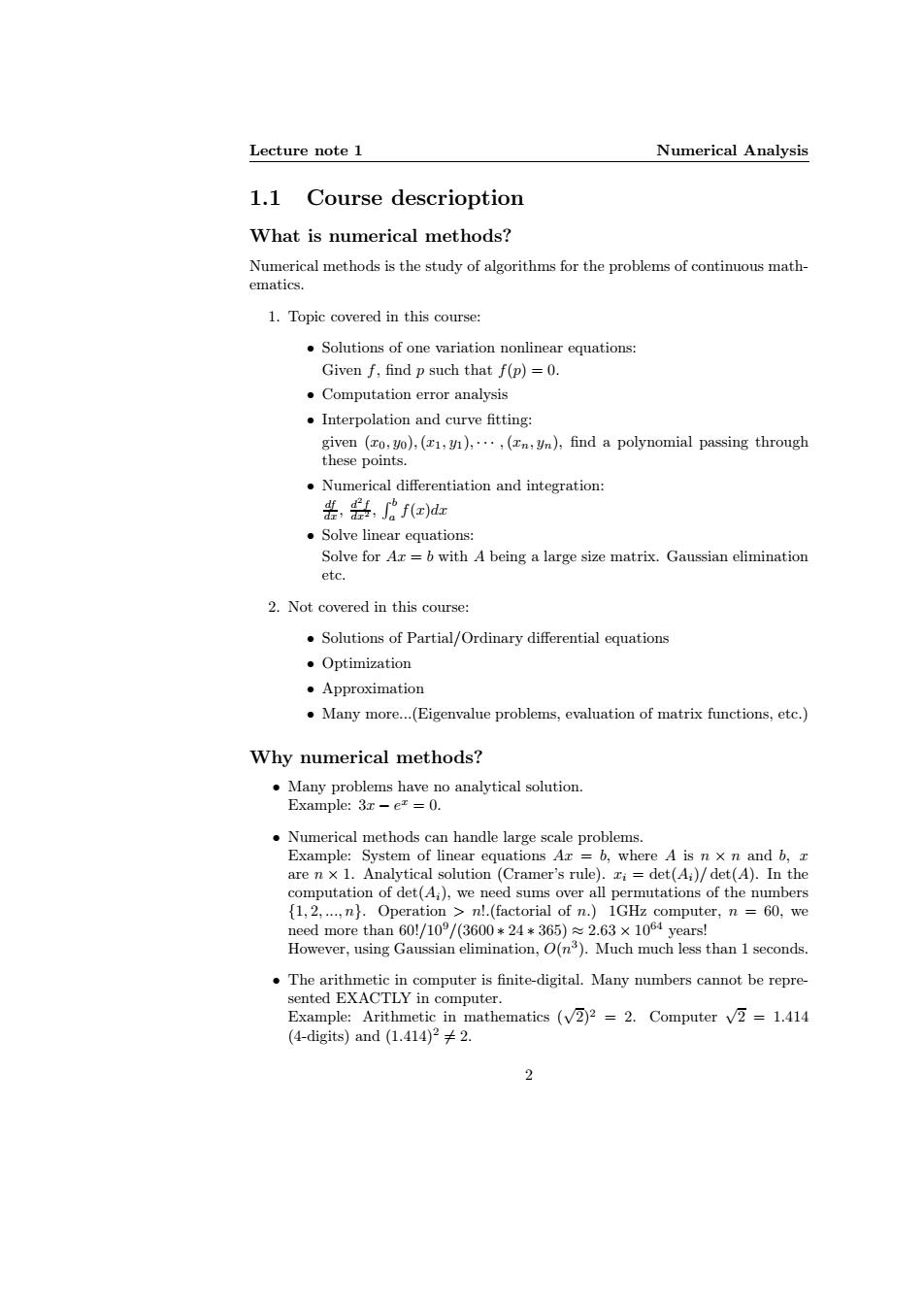正在加载图片...

Lecture note 1 Numerical Analysis 1.1 Course descrioption What is numerical methods? Numerical methods is the study of algorithms for the problems of continuous math- ematics. 1.Topic covered in this course: Solutions of one variation nonlinear equations: Given f,find p such that f(p)=0. Computation error analysis Interpolation and curve fitting: given (xo,y0),(1,y),..,(In,yn),find a polynomial passing through these points. Numerical differentiation and integration: 张,,f)dr Solve linear equations: Solve for Ax=b with A being a large size matrix.Gaussian elimination etc. 2.Not covered in this course: Solutions of Partial/Ordinary differential equations ●Optimization ·Approximation Many more...(Eigenvalue problems,evaluation of matrix functions,etc.) Why numerical methods? Many problems have no analytical solution. Example:3x-e =0. Numerical methods can handle large scale problems. Example:System of linear equations Ax =b,where A is n x n and b,r are n x 1.Analytical solution (Cramer's rule).zi=det(Ai)/det(A).In the computation of det(A;),we need sums over all permutations of the numbers {1,2,...,n}.Operation n!.(factorial of n.)1GHz computer,n =60,we need more than60/10°/(3600*24*365)≈2.63×1064 years! However,using Gaussian elimination,O(n).Much much less than 1 seconds. The arithmetic in computer is finite-digital.Many numbers cannot be repre- sented EXACTLY in computer. Example:Arithmetic in mathematics(√②)2=2.Computer√2=l.4l4 (4-digits)and (1.414)22. 2Lecture note 1 Numerical Analysis 1.1 Course descrioption What is numerical methods? Numerical methods is the study of algorithms for the problems of continuous mathematics. 1. Topic covered in this course: • Solutions of one variation nonlinear equations: Given f, find p such that f(p) = 0. • Computation error analysis • Interpolation and curve fitting: given (x0, y0),(x1, y1), · · · ,(xn, yn), find a polynomial passing through these points. • Numerical differentiation and integration: df dx, d 2 f dx2 , R b a f(x)dx • Solve linear equations: Solve for Ax = b with A being a large size matrix. Gaussian elimination etc. 2. Not covered in this course: • Solutions of Partial/Ordinary differential equations • Optimization • Approximation • Many more...(Eigenvalue problems, evaluation of matrix functions, etc.) Why numerical methods? • Many problems have no analytical solution. Example: 3x − e x = 0. • Numerical methods can handle large scale problems. Example: System of linear equations Ax = b, where A is n × n and b, x are n × 1. Analytical solution (Cramer’s rule). xi = det(Ai)/ det(A). In the computation of det(Ai), we need sums over all permutations of the numbers {1, 2, ..., n}. Operation > n!.(factorial of n.) 1GHz computer, n = 60, we need more than 60!/109/(3600 ∗ 24 ∗ 365) ≈ 2.63 × 1064 years! However, using Gaussian elimination, O(n 3 ). Much much less than 1 seconds. • The arithmetic in computer is finite-digital. Many numbers cannot be represented EXACTLY in computer. Example: Arithmetic in mathematics (√ 2)2 = 2. Computer √ 2 = 1.414 (4-digits) and (1.414)2 6= 2. 2